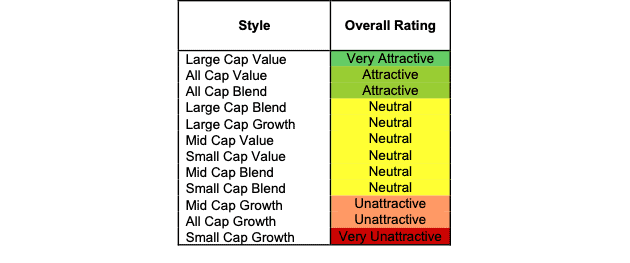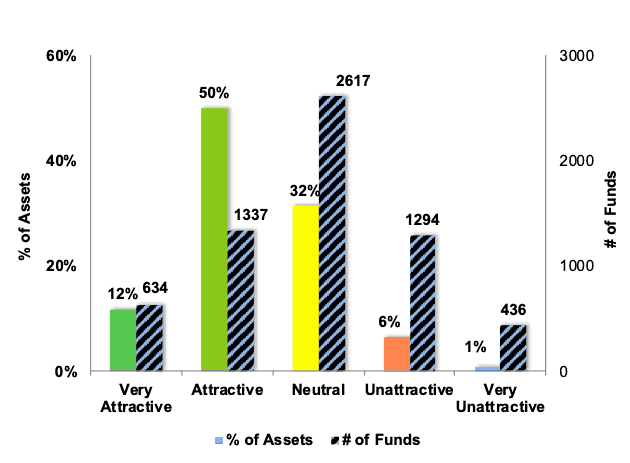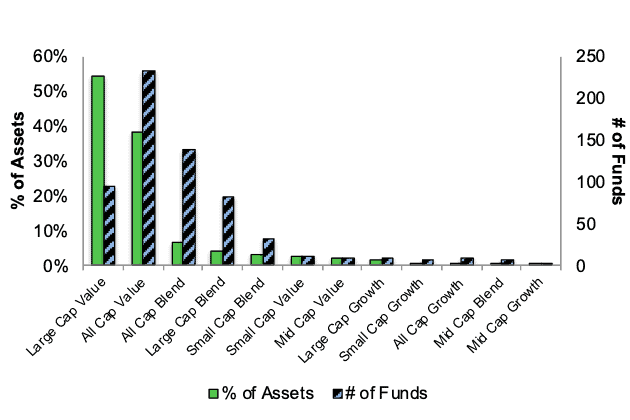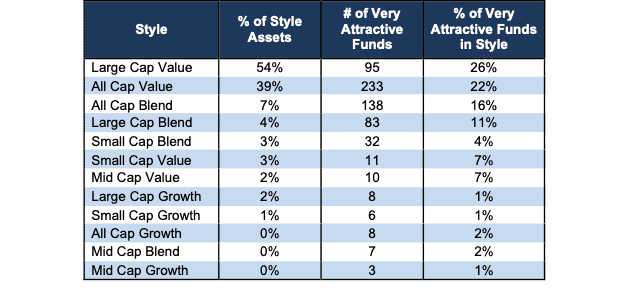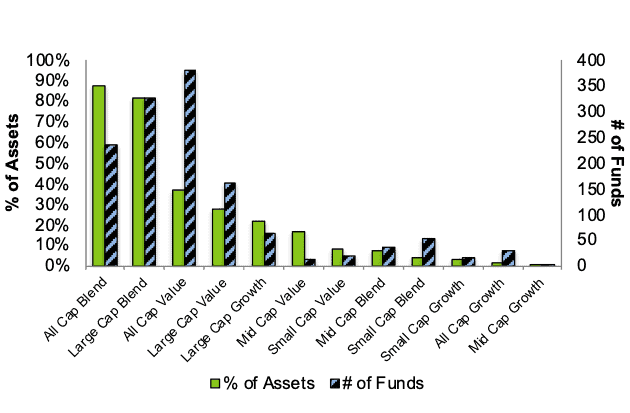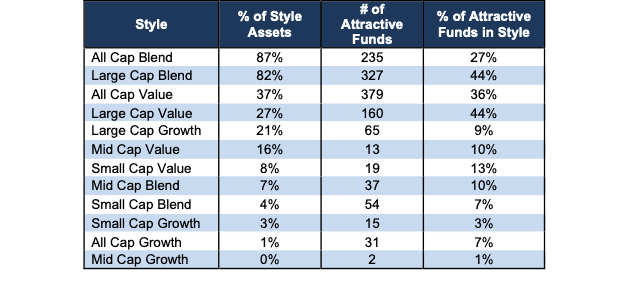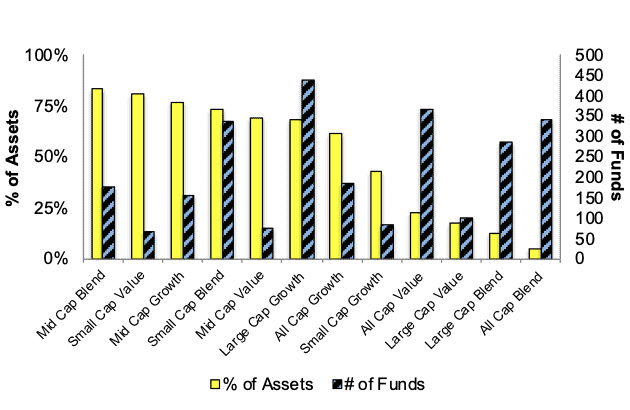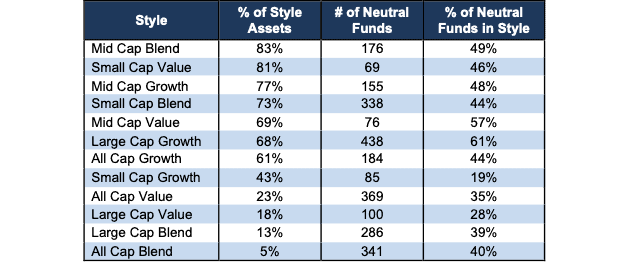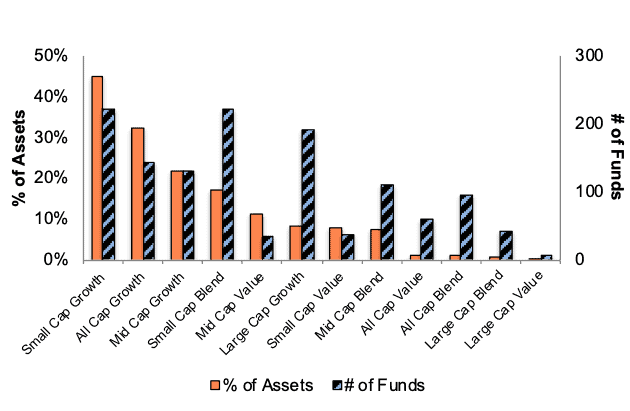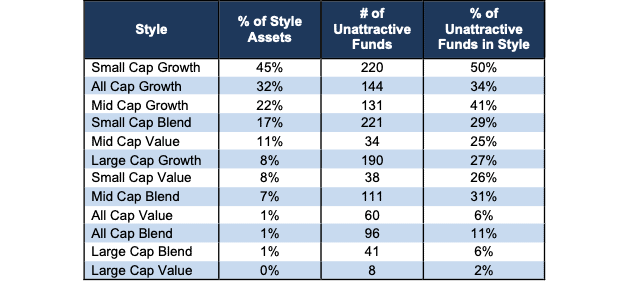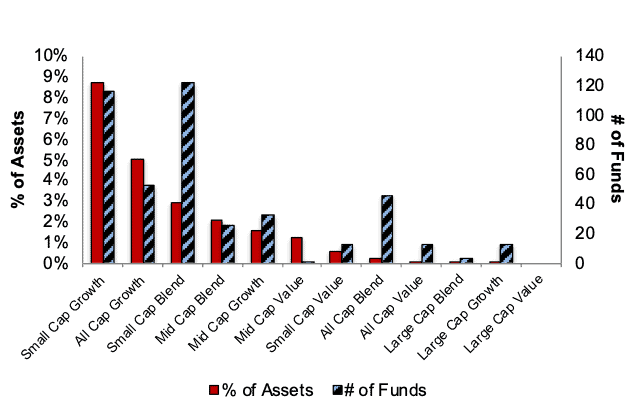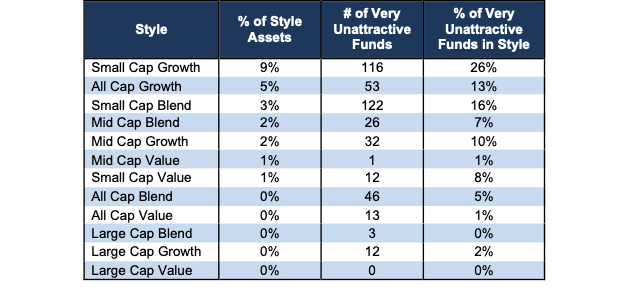At the beginning of 1Q23, the Large Cap Value, All Cap Value, and All Cap Blend styles earn an Attractive-or-better rating. Our style ratings are based on the normalized aggregate of every ETF and mutual fund rating in a given style. Our fund ratings are based on aggregate ratings of fund’s stock holdings. See last quarter’s Style Ratings here.
Investors looking for style funds that hold quality stocks should focus on the Large Cap Value, All Cap Value, and All Cap Blend styles. Figures 4 through 7 provide more details on style ratings, underlying assets, and individual funds. The primary driver behind an Attractive fund rating is good portfolio management with low total annual costs.
Attractive-or-better ratings do not always correlate with low total annual costs. This fact underscores that (1) cheap funds can dupe investors and (2) investors should invest only in funds with good stocks and low fees.
More reliable and proprietary fundamental data, proven in The Journal of Financial Economics, drives our research. Our Robo-Analyst technology[1] empowers our unique ETF and mutual fund rating methodology, which leverages our rigorous analysis of each fund’s holdings.[2] Our Core Earnings[3] and Earnings Distortion factor general novel alpha.
See Figures 4 through 13 for a detailed breakdown of ratings distributions by investment style. See our ETF & mutual fund screener for rankings, ratings, and reports on 6,700+ mutual funds and 900+ ETFs. Our fund rating methodology is detailed here.
All of our reports on the best & worst ETFs and mutual funds in every investment style are available here.
Figure 1: Ratings for All Investment Styles
Source: New Constructs, LLC and company filings
To earn an Attractive-or-better Predictive Rating, an ETF or mutual fund must have high-quality holdings and low costs. Only the top 30% of all ETFs and mutual funds earn an Attractive-or-better rating.
Exchange Traded Concepts Meridian Mega Cap Equity ETF (SIXA) is the top-rated Large Cap Value fund that meets our liquidity minimum. It gets our Very Attractive rating by allocating over 44% of its assets to stocks rated Attractive-or-better.
Capital Series Fuller & Thaler Behavioral Small Cap Growth Fund (FTXAX) is the worst-rated Small Cap Growth fund. It earns our Very Unattractive rating by allocating over 50% of its assets to stocks rated Unattractive-or-worse. Worse yet, it charges investors total annual costs of 4.19%. Figure 2 shows the distribution of our Predictive Ratings for all investment style ETFs and mutual funds
Figure 2: Distribution of ETFs & Mutual Funds (Assets and Count) by Predictive Rating
Source: New Constructs, LLC and company filings
Figure 3 offers additional details on the quality of investment style funds. Note that the average total annual cost of Very Unattractive funds is almost five times that of Very Attractive funds.
Figure 3: Predictive Rating Distribution Stats
* TNA = Total Net Assets
** Avg TAC = Weighted Average Total Annual Costs
Source: New Constructs, LLC and company filings
Ratings by Investment Style
Figure 4 presents a mapping of Very Attractive funds by investment style. The chart shows the number of Very Attractive funds in each style and the percentage of assets allocated to funds rated Very Attractive.
Figure 4: Very Attractive ETFs & Mutual Funds by Investment Style
Source: New Constructs, LLC and company filings
Figure 5 presents the data charted in Figure 4.
Figure 5: Very Attractive ETFs & Mutual Funds by Investment Style
Source: New Constructs, LLC and company filings
Figure 6 presents a mapping of Attractive funds by investment style. The chart shows the number of Attractive funds in each style and the percentage of assets allocated to funds rated Attractive.
Figure 6: Attractive ETFs & Mutual Funds by Investment Style
Source: New Constructs, LLC and company filings
Figure 7 presents the data charted in Figure 6.
Figure 7: Attractive ETFs & Mutual Funds by Investment Style
Source: New Constructs, LLC and company filings
Figure 8 presents a mapping of Neutral funds by investment style. The chart shows the number of Neutral funds in each style and the percentage of assets allocated to funds rated Neutral.
Figure 8: Neutral ETFs & Mutual Funds by Investment Style
Source: New Constructs, LLC and company filings
Figure 9 presents the data charted in Figure 8.
Figure 9: Neutral ETFs & Mutual Funds by Investment Style
Source: New Constructs, LLC and company filings
Figure 10 presents a mapping of Unattractive funds by investment style. The chart shows the number of Unattractive funds in each style and the percentage of assets allocated to funds rated Unattractive.
The landscape of style ETFs and mutual funds is littered with Unattractive funds. Investors in Small Cap Growth have put over 45% of their assets in funds rated Unattractive.
Figure 10: Unattractive ETFs & Mutual Funds by Investment Style
Source: New Constructs, LLC and company filings
Figure 11 presents the data charted in Figure 10.
Figure 11: Unattractive ETFs & Mutual Funds by Investment Style
Source: New Constructs, LLC and company filings
Figure 12 presents a mapping of Very Unattractive funds by investment style. The chart shows the number of Very Unattractive funds in each style and the percentage of assets allocated to funds rated Very Unattractive.
Figure 12: Very Unattractive ETFs & Mutual Funds by Investment Style
Source: New Constructs, LLC and company filings
Figure 13 presents the data charted in Figure 12.
Figure 13: Very Unattractive ETFs & Mutual Funds by Investment Style
Source: New Constructs, LLC and company filings
This article was originally published on January 20, 2023.
Disclosure: David Trainer, Kyle Guske II, Matt Shuler, and Italo Mendonça receive no compensation to write about any specific stock, sector or theme.
Follow us on Twitter, Facebook, LinkedIn, and StockTwits for real-time alerts on all our research.
[1] Harvard Business School features our research automation technology in the case Disrupting Fundamental Analysis with Robo-Analysts.
[2] See how our models overcome flaws in Bloomberg and Capital IQ’s (SPGI) analytics in the detailed appendix of this paper.
[3] The Journal of Financial Economics proves that only Core Earnings enable investors to overcome the flaws in legacy fundamental data.

